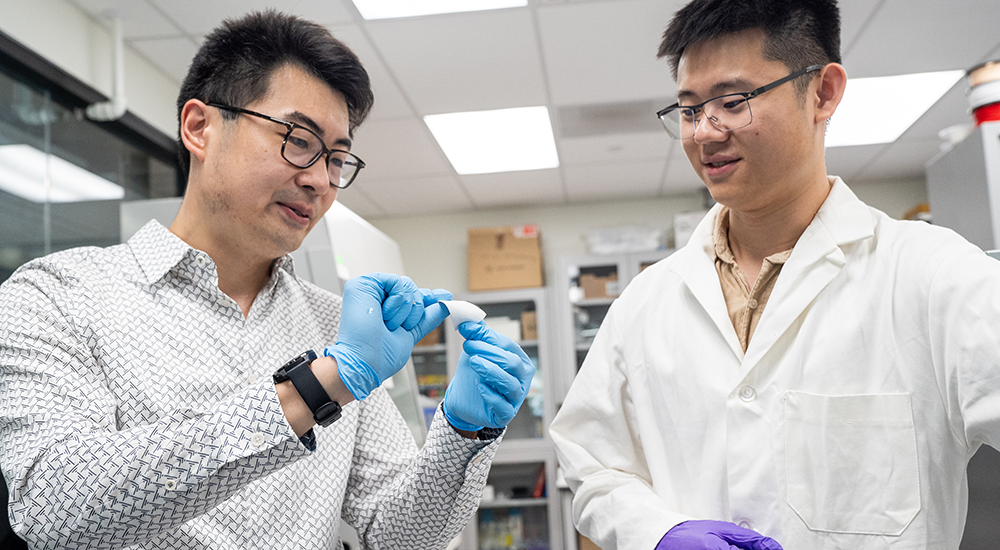Media
Contact
Communications Specialist
Faculty of Engineering
Spencer Engineering Building
Room 2072
Western University
Tel: 519-661-2111 ext. 87015
Email: engineeringcomms@uwo.ca
A '4R' framework for bringing sustainable e-textiles to scale

HaoTian Harvey Shi (left) with Masters student Xiaohan Jackie Wu, demonstrating a flexible thin-film energy storage device that can be attached on e-textile products to provide power.
We’ve been wearing textiles as clothing for more than 100,000 years. We’ve worn them for warmth and protection, but also as a way of sharing our personalities. But in recent times, we increasingly expect them to do quite a bit more than that.
With electronics becoming more flexible and the Internet being integrated into nearly all facets of our day-to-day lives, the interest in electronic textiles – or e-textiles – is on the rise. Wearable electronics have a wide range of applications, including storing and harvesting energy, monitoring our health and tracking athletic performances.
But according to HaoTian Harvey Shi, assistant professor in the department of Mechanical and Materials Engineering, the commercialization of e-textiles still faces two major challenges.
“First, there is a rather sluggish adoption of e-textiles from consumers for a variety of reasons, including short lifespans for some of these products,” he says. “But secondly, there are major environmental costs to produce e-textiles at scale”.
In a perspective published in Nature Materials, Shi notes that electronic waste has become the fastest-growing waste stream in the world and that an emergent e-textile market would only add to the global environmental burden.
Shi leads the D2M Laboratory at Western Engineering, investigating novel micro- and nanostructured materials for wearable energy storage, biosensing, electronic skin and medical implant applications. He proposes that to fully realize the benefit and impact of e-textiles while also ensuring a sustainable circular economy we need to move to what he describes as ‘4R e-textile design’.
“To enable a true circular economy for e-textiles, we propose a repair, recycle, replacement and reduction – or 4R - circular e-textile paradigm," he says. "Novel materials and technologies are the enablers of each of these areas. For example, for the robust repair of e-textiles, researchers might want to consider fiber level repair techniques that involve resewing, reweaving, and self-healing of electronic fibers by utilizing shape memory threads."
"Or in the case of reduction, we can use fiber-on-demand strategies to 3D-print functional e-textile yarns instead of the traditional large-scale dip coating and dyeing, which would significantly reduce overall emissions and minimize materials usage."
Shi believes that adopting these 4R principles with more standardization across the industry could lead to an e-textiles market where we have self-cleaning and self-repairing wearable technologies that are also biodegradable and biocompatible.
At D2M, Shi and the team are working on bringing these concepts to reality. By developing a multi-nozzle direct-ink-writing method, the group is able to create bio-based, fully sustainable, fiber-type pressure sensors, biosensors, and energy storage devices on demand, which can be easily integrated with future e-textiles and wearable electronics.

